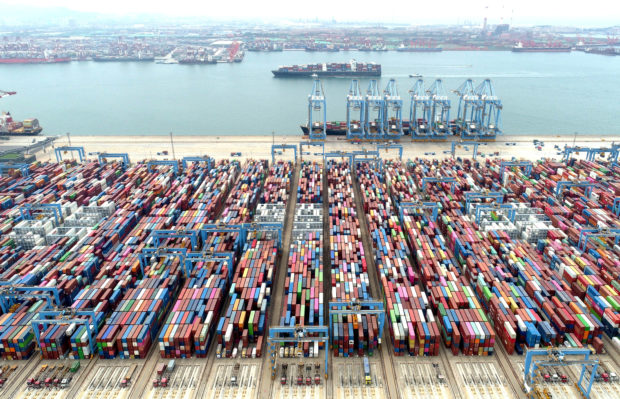
An aerial view shows containers and cargo vessels at the Qingdao port in Shandong province, China. Picture taken with a drone. China Daily via REUTERS/File photo
BEIJING – China’s exports growth weakened in August, as surging inflation crippled overseas demand and fresh COVID curbs and heatwaves disrupted production, reviving downside risks for the economy.
Exports rose 7.1 percent in August from a year earlier, slowing from an 18 percent gain in July, official customs data showed on Wednesday. The reading missed analysts’ expectations for a 12.8 percent increase.
Outbound shipments outperformed other economic drivers in 2022 but now face growing challenges as external demand wanes.
China’s slower growth is in part due to unflattering comparisons to strong exports last year, but also worsened by more COVID restrictions as infections spiked and heatwaves disrupted factory output in southwestern areas.
Eastern export hub Yiwu imposed a three-day lockdown in early August to contain a COVID outbreak, disrupting local shipments and delivery of Christmas goods amid the peak season.
Imports were again tepid, rising only 0.3 percent in August from 2.3 percent in the month prior, the customs data showed, and well below a forecast for a 1.1 percent rise.
The weak domestic demand, dampened by the worst heatwaves in decades, a property crisis and sluggish consumption, crippled imports.
Global commodity prices continued to fall in August, though at a slower pace.
This left a narrower trade surplus of $79.39 billion, compared with a $101.26 billion surplus in July, which was a record for single-month goods trade balance for any country in history.
Analysts at Goldman Sachs expect China’s elevated levels of trade surpluses to sustain over the next few years but warned key risks are geopolitical tensions and substantially higher commodity prices over the medium-term.
Assistant Commerce Minister Li Fei said on Monday China’s foreign trade faces unfavorable factors, including weakening external demand.
The central bank on Monday said it would cut the amount of foreign exchange reserves financial institutions must hold, a move aimed at slowing the yuan’s recent depreciation.


